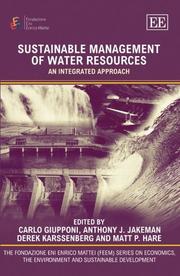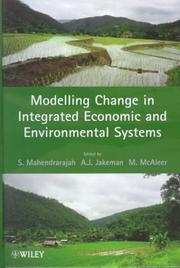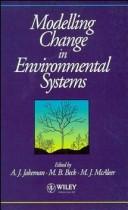| Listing 1 - 6 of 6 |
Sort by
|
Book
ISBN: 128191116X 9786611911164 0080915302 0080568866 9780080915302 9780080568867 Year: 2008 Publisher: Oxford : Elsevier Science,
Abstract | Keywords | Export | Availability | Bookmark
 Loading...
Loading...Choose an application
- Reference Manager
- EndNote
- RefWorks (Direct export to RefWorks)
The complex and multidisciplinary nature of environmental problems requires that they are dealt with in an integrated manner. Modeling and software have become key instruments used to promote sustainability and improve environmental decision processes, especially through systematic integration of various knowledge and data and their ability to foster learning and help make predictions. This book presents the current state-of-the-art in environmental modeling and software and identifies the future challenges in the field.* State-of-the-art in environmental modeling and software theory a
Environmental sciences --- Environmental sciences. --- Computer simulation. --- Environmental science --- Science
Multi
ISBN: 9780080915302 0080915302 9780080568867 0080568866 Year: 2008 Publisher: Boston Elsevier
Abstract | Keywords | Export | Availability | Bookmark
 Loading...
Loading...Choose an application
- Reference Manager
- EndNote
- RefWorks (Direct export to RefWorks)
The complex and multidisciplinary nature of environmental problems requires that they are dealt with in an integrated manner. Modeling and software have become key instruments used to promote sustainability and improve environmental decision processes, especially through systematic integration of various knowledge and data and their ability to foster learning and help make predictions. This book presents the current state-of-the-art in environmental modeling and software and identifies the future challenges in the field. State-of-the-art in environmental modeling and software theory and practice for integrated assessment and management serves as a starting point for researchers. Identifies the areas of research and practice required for advancing the requisite knowledge base and tools, and their wider usage. Best practices of environmental modeling enables the reader to select appropriate software and gives the reader tools to integrate natural system dynamics with human dimensions.

ISBN: 1845427459 9781845427450 Year: 2006 Publisher: Cheltenham Northampton : Edward Elgar,
Abstract | Keywords | Export | Availability | Bookmark
 Loading...
Loading...Choose an application
- Reference Manager
- EndNote
- RefWorks (Direct export to RefWorks)

ISBN: 0471985449 Year: 1999 Publisher: New York Chichester Weinheim Wiley
Abstract | Keywords | Export | Availability | Bookmark
 Loading...
Loading...Choose an application
- Reference Manager
- EndNote
- RefWorks (Direct export to RefWorks)

ISBN: 0471957801 0471942634 9780471942634 Year: 1993 Publisher: Chichester Wiley
Abstract | Keywords | Export | Availability | Bookmark
 Loading...
Loading...Choose an application
- Reference Manager
- EndNote
- RefWorks (Direct export to RefWorks)
Climatic changes --- Environmental sciences --- Mathematical models. --- Technique. --- Changement climatique --- Modèle --- Models --- Cycle biogéochimique --- cycling --- Sociology of environment --- Hydrology --- Climatic change --- ecosystems --- environment --- Mathematical models --- Technique --- Environmental sciences - Mathematical models. --- Environmental sciences - Technique. --- Hydrology - Mathematical models. --- Climatic changes - Mathematical models.
Book
ISBN: 1786843234 3319235761 3319235753 Year: 2016 Publisher: Cham Springer Nature
Abstract | Keywords | Export | Availability | Bookmark
 Loading...
Loading...Choose an application
- Reference Manager
- EndNote
- RefWorks (Direct export to RefWorks)
The aim of this book is to document for the first time the dimensions and requirements of effective integrated groundwater management (IGM). Groundwater management is a formidable challenge, one that remains one of humanity’s foremost priorities. It has become a largely non-renewable resource that is overexploited in many parts of the world. In the 21st century, the issue moves from how to simply obtain the water we need to how we manage it sustainably for future generations, future economies, and future ecosystems. The focus then becomes one of understanding the drivers and current state of the groundwater resource, and restoring equilibrium to at-risk aquifers. Many interrelated dimensions, however, come to bear when trying to manage groundwater effectively. An integrated approach to groundwater necessarily involves many factors beyond the aquifer itself, such as surface water, water use, water quality, and ecohydrology. Moreover, the science by itself can only define the fundamental bounds of what is possible; effective IGM must also engage the wider community of stakeholders to develop and support policy and other socioeconomic tools needed to realize effective IGM. In order to demonstrate IGM, this book covers theory and principles, embracing: 1) an overview of the dimensions and requirements of groundwater management from an international perspective; 2) the scale of groundwater issues internationally and its links with other sectors, principally energy and climate change; 3) groundwater governance with regard to principles, instruments and institutions available for IGM; 4) biophysical constraints and the capacity and role of hydroecological and hydrogeological science including water quality concerns; and 5) necessary tools including models, data infrastructures, decision support systems and the management of uncertainty. Examples of effective, and failed, IGM are given. Throughout, the importance of the socioeconomic context that connects all effective IGM is emphasized. Taken as a whole, this work relates the many facets of effective IGM, from the catchment to global perspective.
Earth sciences. --- Environmental management. --- Hydrogeology. --- Sustainable development. --- Economic growth. --- Earth Sciences. --- Water Policy/Water Governance/Water Management. --- Economic Growth. --- Sustainable Development. --- Development, Economic --- Economic growth --- Growth, Economic --- Economic policy --- Economics --- Statics and dynamics (Social sciences) --- Development economics --- Resource curse --- Development, Sustainable --- Ecologically sustainable development --- Economic development, Sustainable --- Economic sustainability --- ESD (Ecologically sustainable development) --- Smart growth --- Sustainable development --- Sustainable economic development --- Economic development --- Geohydrology --- Geology --- Hydrology --- Groundwater --- Environmental stewardship --- Stewardship, Environmental --- Environmental sciences --- Management --- Geosciences --- Physical sciences --- Environmental aspects --- Hydraulic engineering. --- Engineering, Hydraulic --- Engineering --- Fluid mechanics --- Hydraulics --- Shore protection --- Adaptación a los Cambios del Medio Físico (71052207) --- Bibliografía recomendada --- Water management --- Hydrogeology
| Listing 1 - 6 of 6 |
Sort by
|

 Search
Search Feedback
Feedback About UniCat
About UniCat  Help
Help News
News